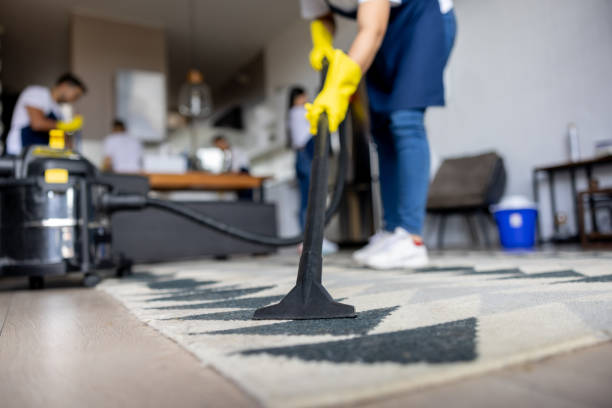Kick Construction Dust and Debris to the Curb
After any construction project, cleaning up can be a monumental task, especially when it comes to cleaning commercial floors. Cleaning up just needs a little elbow grease and the right strategy.
Tackle the Dust: No Hazmat Suit Required
First, don’t panic. You don’t need to look like you’re trying out for a sci-fi flick to deal with the dust. Start by putting on a good quality mask. Nothing fancy, just something to keep the particles out of your lungs.
Now, let’s talk tools. A high-efficiency vacuum cleaner is your new best friend. One with a HEPA filter is even better. It’s the rock star of dust busters. Run it gently across every inch of the floor, slow and steady wins the race. Don’t rush it.
Mopping Like a Pro
Once the vacuum has done its magic, it’s mop time. Warm water with a touch of dish soap works wonders, but don’t go overboard with the suds. You’re aiming for clean floors, not a foam party.

Start mopping from the far corner of the room and work your way back towards the entrance. Rinse your mop frequently. You don’t want to spread the gunk around. If your floor is giving you the silent treatment, and you’re not entirely sure if it’s clean, it’s likely not. Mop again until you see that satisfying shine.
Taming the Stubborn Debris
Let’s face it; dust isn’t the only villain in your cleaning saga. Debris can be sneaky and stick like glue. For larger chunks, a push broom with stiff bristles can be your hero. A good old dustpan is a trusty sidekick.
For those tiny specks that elude the broom, revisit your vacuum cleaner. Think of it as a superhero doing its final sweep. It may seem redundant, but trust me, it’s worth the effort. You don’t want to find stray bits later that could scratch up your spic-and-span floors.
The Floor Type Conundrum
Believe it or not, not all floors are created equal. Each type calls for its own special care. If you’ve got hardwood, be gentle. Excess water won’t win you any brownie points here and can cause damage. For tiles, a bit more water is fine, but ditch the abrasive cleaners which can ruin the finish.
Concrete? It’s robust but not bulletproof. Go for neutral pH cleaners to avoid any dull spots. Vinyl? Think gentle. A mild detergent will do wonders here. Choosing the right cleaner for the material at hand is like finding the perfect match on a dating app – it’s crucial for a happy union.
Finishing Touches That Sparkle
Finally, don’t forget the finishing touches. After mopping and scrubbing, sometimes floors can look a little dull. A quick buff with a dry mop can bring back the shine. If you’re feeling fancy, a good polish can make those floors gleam.
Protecting Your Hard Work
To prevent future dust disasters, consider some protective measures. Doormats can catch a lot of dirt before it makes a mess inside. It’s a small step that keeps everything pristine.
Chatting with Experience
A buddy of mine once recounted his post-renovation woes. He skipped the vacuum stage and went straight to mopping. Big mistake! The result? Muddy streaks everywhere. So, my advice: don’t skip steps, or you could end up redoing the entire process. Just like cooking, there’s an order to things. Trust the process.
Cleaning up post-construction doesn’t have to be a nightmare. With some patience and the right tools, you can turn chaos into calm, and your commercial floors will thank you for it. It’s time to let those floors shine like the top of the Chrysler Building!
Expert Tips for Protecting New Floors from Post-Construction Damage
Congratulations! Your new floors look fantastic. cleaning commercial floors might seem straightforward, but post-construction can be messy and hectic. Protecting your pristine surfaces becomes a priority. Here are some handy, savvy, and sometimes amusing tips to keep your floors looking spick-and-span.
First things first, cover your floors. Use a sturdy sheet of cardboard, contractor paper, or a specialized floor protector. Old sheets? They won’t cut the mustard. Remember, a stitch in time saves nine, or in this case, a scratch that will make you whine.
Next, implement a no-shoes rule. Construction dust, grime, and tiny rocks can wreak havoc on your new investment. Set up a designated shoe zone by the entry to avoid tracking debris inside. You’re not just playing footsies with cleanliness—you’re embracing a savvy move to keep floors intact.
Also, when you need to move furniture back in, do yourself a favor—get some furniture sliders. These little gems will save you the heartbreak of discovering a scratch longer than your favorite TV series. Just ask my cousin who learned the hard way when redecorating his home. Furniture sliders are a small price to pay for maintaining a scratch-free floor.
After covering up and adopting the no-shoe rule, come the heavy-duty mats. Place high-quality mats both outside and just inside the entryway. It’s like having your very own floor bouncers, making sure only clean feet get past the velvet rope. This trick works wonders for trapping dirt, moisture, and other nasties.
Now for the important bit—cleaning. Let’s talk about vacuuming. Use an attachment with soft bristles to avoid accidentally scratching the surface. And mop sparingly! Too much water can warp wood or laminate floors quicker than you can say, “where did that puddle come from?”
For anyone fortunate enough to have wooden floors, the first three months are crucial. Wood needs time to settle, like wine. So, keep those humidity levels balanced. Use humidifiers or dehumidifiers if needed. It’s all about creating a Goldilocks scenario—not too wet, not too dry, but just right.
For those using cleaners, keep it gentle. Avoid harsh chemicals like you’d avoid a brick wall on a skateboard. Opt for pH-neutral cleaners. Trust me, your floor will thank you. A homemade mix of water and vinegar can also do wonders if used sparingly.
One often overlooked tip is focusing on the baseboards and molding. Dust settles here first before finding refuge in the nooks and crannies of your flooring. Keeping these clean reduces overall dust and grime. Think of them as tiny battlegrounds where the war on dirt begins.
Construction projects often leave hazy residues that sneak into every crevice. A mild cleaner suited for the type of floor you have, coupled with a microfiber cloth, can clear this up. If you see any residue post-construction, spot-clean immediately.
Lastly, stay ahead of the game by having regular floor inspections. It’s less about finding something wrong and more about affirming everything is right. Being proactive is key, and you get to keep living your best, worry-free life.
Taking these steps might sound like a chore, but in the grand scheme of things, it’s less about the effort and more about preserving a big investment.






